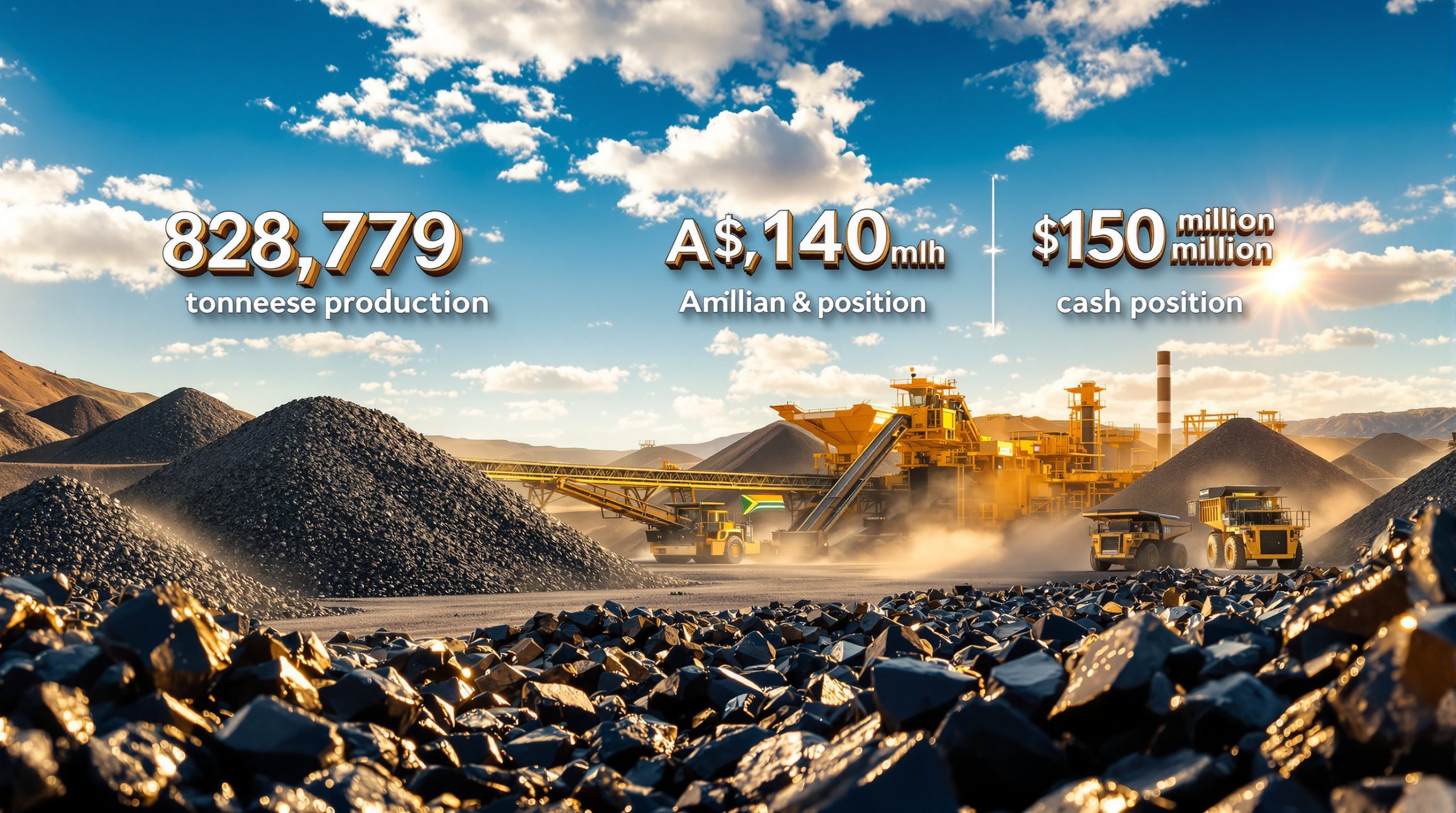Government Partnership Transforms Australia's Critical Minerals Processing Landscape
Australia's critical minerals sector has witnessed its most significant investment milestone as Alpha HPA funding for largest HPA plant secures unprecedented government backing for what will become the world's largest single-site ultra-high purity alumina facility. The $430 million combined funding package demonstrates extraordinary confidence in domestic value-adding capabilities and positions Queensland as a global manufacturing hub for next-generation technologies.
The Queensland Government's $30 million commitment through Queensland Investment Corporation, combined with the federal government's earlier $400 million debt financing package, creates one of the most substantial public-private partnerships in Australia's downstream processing history. Furthermore, this strategic alignment between state and federal authorities signals a fundamental shift toward supporting domestic mineral processing rather than raw commodity exports.
This achievement directly supports Australia's broader critical minerals strategy whilst establishing new benchmarks for international competitiveness. Additionally, the project demonstrates sophisticated mining innovation trends that position Australia as a leader in value-added processing capabilities.
Securing Record-Breaking Investment Through Strategic Government Partnerships
The funding achievement represents a carefully orchestrated collaboration between multiple government entities, each contributing specialised expertise and financial resources. Queensland Investment Corporation's involvement through royalty deed structures provides a sustainable revenue-sharing mechanism that aligns government returns with project success, while federal partners bring export finance capabilities and infrastructure development focus.
Queensland's Strategic $30 Million Royalty Investment
Queensland Investment Corporation's $30 million contribution employs an innovative royalty deed structure across Alpha HPA subsidiaries, creating long-term funding mechanisms that extend beyond traditional equity or debt arrangements. This approach provides the Queensland Government with ongoing revenue participation while supporting the project's stage two development requirements.
The royalty framework demonstrates sophisticated risk management, allowing government participation in project upside while maintaining flexibility for future expansion phases. Jonathan Crombie from Queensland Investment Corporation emphasised that the funding reflects strong confidence in Alpha HPA's leadership team and positions the project as central to Queensland's clean energy transition objectives.
Federal Support Through Comprehensive Debt Facilities
The $400 million senior debt financing package, delivered through Export Finance Australia and the Northern Australia Infrastructure Facility partnership, provides the primary construction capital for the Gladstone facility. This federal commitment operates under the Australian Government's Critical Minerals Facility program, indicating strategic classification alongside other nationally significant projects.
Export Finance Australia's involvement brings specialised expertise in export-oriented project financing, while the Northern Australia Infrastructure Facility contributes regional development focus and infrastructure connectivity enhancement. John Hopkins from Export Finance Australia confirmed continued partnership under the Critical Minerals Facility, emphasising government commitment to Australia's critical minerals sector advancement.
The partnership structure suggests sophisticated risk allocation between construction phases, operational ramp-up periods, and long-term market positioning, providing comprehensive financial coverage across the project lifecycle.
Unprecedented Production Scale Positions Australia as Global HPA Leader
The Gladstone facility's specification as the world's largest single-site HPA production centre reflects both ambitious production targets and advanced processing capabilities. With 10,000+ tonnes annual output capacity across multiple purity grades, the facility will significantly influence global HPA supply dynamics and establish Australia as a primary source for technology-grade materials.
Production Capacity and Technical Specifications
The facility's 10-hectare footprint within Gladstone's established industrial precinct provides strategic advantages through existing infrastructure, port access, and skilled workforce availability. The dual capability for 4N (99.99%) and 5N (99.999%) purity grades within a single facility represents operational flexibility uncommon in global HPA production.
| Production Specifications | Details |
|---|---|
| Annual Capacity | 10,000+ tonnes |
| Purity Grades | 4N (99.99%) and 5N (99.999%) |
| Facility Size | 10 hectares |
| Location | Gladstone Industrial Precinct, Queensland |
The 4N grade serves standard semiconductor and electronic component applications, while 5N grade meets advanced semiconductor substrate requirements and high-specification technology applications. Consequently, this dual capability positions the facility to serve diverse market segments without operational limitations.
Global Market Context and Competitive Positioning
The 10,000+ tonnes annual capacity represents substantial market presence when compared to existing global production. Current HPA supply chains concentrate heavily in Asia, with limited Western production capabilities, creating supply security concerns for technology manufacturers in allied nations.
Australia's entry as a major HPA producer provides geographic diversification and supply chain resilience for technology sectors increasingly focused on critical material security. In addition, the facility's location within established shipping routes to Asia-Pacific technology manufacturing centres offers logistical advantages over alternative supply sources.
Technology Supply Chains Drive HPA Demand Across Multiple Industries
The facility's output targets critical applications across expanding technology sectors, with particular focus on artificial intelligence infrastructure, electric vehicle components, and advanced manufacturing processes. These industries require ultra-pure materials with consistent quality specifications and reliable supply chains.
Semiconductor and AI Infrastructure Applications
HPA serves as essential substrate material for AI chip manufacturing, where 5N purity requirements support advanced processor fabrication. The growing demand for AI computing infrastructure drives increasing requirements for high-specification materials with verified provenance and quality control.
Sapphire glass production, utilising HPA as feedstock, creates components for LED lighting systems, optical equipment, and specialised electronic applications. However, Alpha HPA's parallel development of HPA First and Sapphire Glass projects demonstrates vertical integration strategy, maximising value capture within Queensland's manufacturing ecosystem.
Electric Vehicle Battery Integration
Electric vehicle battery systems utilise HPA in separator coating applications and thermal management components, where material purity directly impacts battery performance and longevity. As electric vehicle adoption accelerates globally, HPA demand for automotive applications continues expanding, supporting energy transition security objectives.
The automotive industry's increasing focus on supply chain transparency and material traceability creates advantages for Australian-produced HPA, offering verified sourcing and quality assurance systems meeting international automotive standards.
Project Timeline Reflects Sophisticated Development Strategy
The project's progression through structured development phases demonstrates comprehensive planning and risk management across construction, commissioning, and production ramp-up periods. Current funding announcement in October 2025 supports stage two development, building upon previously completed foundational work.
Construction and Production Milestones
With funding secured for stage two development, the project advances through detailed engineering, equipment procurement, and construction execution phases. The mid-2026 first production target provides approximately 20 months for construction completion and commissioning activities.
Investment Perspective: The structured timeline with distinct development phases provides investors and government partners with clear milestone-based progress monitoring and risk assessment capabilities.
The progression toward 2027-2028 full capacity operations suggests gradual production ramp-up, allowing market development and customer qualification processes to align with increasing output volumes.
Regulatory Framework and Approval Progress
The project operates within Queensland's established industrial regulatory framework, benefiting from Gladstone's existing approvals infrastructure and environmental management systems. Federal Critical Minerals Facility designation provides additional regulatory coordination and support mechanisms.
Environmental impact assessments and operational permits progress through established Queensland Government processes, with federal government backing demonstrating regulatory alignment and strategic project classification.
Strategic Implications for Australia's Critical Minerals Competitiveness
The investment represents fundamental advancement in Australia's approach to critical minerals development, emphasising domestic value-adding capabilities over raw material exports. This approach creates higher-value employment, technology transfer opportunities, and enhanced export revenue through processed products rather than ore concentrates.
This aligns with broader efforts to establish a comprehensive critical minerals reserve whilst providing insights comparable to international CRM facility insights for supply chain security.
Domestic Value-Adding Capabilities
Processing HPA domestically rather than exporting raw materials generates substantially higher economic returns while developing advanced manufacturing capabilities. The project creates opportunities for technology transfer, intellectual property development, and skills formation within Australia's minerals processing sector.
Rob Williamson from Alpha HPA emphasised the project's role in demonstrating Australia's ability to deliver value-added critical minerals products onshore, highlighting strategic importance of domestic processing capabilities for national economic security.
Supply Chain Security and International Competitiveness
The facility addresses supply chain vulnerabilities in critical technology materials while positioning Australia as reliable supplier to allied nations' technology industries. Geographic diversification away from concentrated Asian production provides strategic advantages for Western technology manufacturers.
Australia's established mining expertise, regulatory frameworks, and trade relationships create competitive advantages in developing secure, sustainable HPA supply chains for international customers requiring verified material sourcing.
Government Partners Enable Comprehensive Risk Management
The multi-entity government partnership distributes project risks across specialised public sector capabilities while providing comprehensive support mechanisms. Each partner organisation contributes distinct expertise areas and financial resources aligned with specific project requirements.
Export Finance Australia's Strategic Framework
Export Finance Australia's participation through the Critical Minerals Facility program provides specialised export project financing capabilities, including international market development support and customer relationship facilitation. This expertise proves essential for establishing global customer bases and long-term supply contracts.
The agency's involvement indicates federal government recognition of HPA's strategic importance and export potential, supporting market development activities and international competitive positioning.
Queensland Investment Corporation's Long-Term Commitment
Queensland Investment Corporation's royalty deed structure creates alignment between state government returns and project operational success, encouraging ongoing support throughout the facility's operational life. This approach provides sustainable funding relationships extending beyond initial construction phases.
For instance, the investment framework supports future expansion possibilities and technology development initiatives, creating pathways for continued Queensland Government participation in sector growth.
Regional Economic Development Through Advanced Manufacturing
The Gladstone facility's economic impact extends beyond direct project employment, creating multiplier effects through supply chain development, skills formation, and advanced manufacturing ecosystem attraction. The 10-hectare facility within established industrial infrastructure maximises regional development benefits.
Employment Creation and Skills Development
Construction and operational phases generate direct employment opportunities while requiring specialised skills development programs supporting advanced manufacturing capabilities. The project's location within Queensland's existing industrial workforce base provides recruitment advantages and training program foundations.
Regional economic benefits extend through increased local spending, supply chain development, and attraction of complementary manufacturing operations seeking proximity to HPA production capabilities.
Advanced Manufacturing Ecosystem Growth
The facility's establishment creates opportunities for downstream processing development and technology-focused industries requiring high-purity materials. Research and development collaborations with universities and technology companies provide additional economic development pathways.
Queensland's positioning as advanced manufacturing hub benefits from demonstration of sophisticated processing capabilities and government support for value-adding industries.
Technology Differentiation Creates Competitive Advantages
Alpha HPA's processing approach utilises kaolin clay feedstock rather than traditional bauxite sources, providing potential environmental and cost advantages. The proprietary processing technology enables dual purity grade production within integrated facility operations.
Process Innovation and Environmental Benefits
The kaolin-based processing approach potentially offers reduced environmental impact compared to traditional alumina production methods, supporting sustainability objectives while maintaining competitive cost structures. Advanced process control enables consistent quality production across different purity specifications.
Dual-grade production capability within single facility operations provides market flexibility and operational efficiency advantages over single-purpose facilities requiring separate production lines for different purity levels.
Quality Assurance and International Standards
Australian production offers traceability and quality assurance advantages for international customers requiring verified material sourcing and environmental compliance documentation. Established Australian regulatory frameworks support international certification requirements and trade relationship development.
The facility's design incorporates advanced quality control systems ensuring consistent product specifications and customer requirement compliance across varied applications and purity grades.
Market Conditions Support Strategic Investment Timing
Global HPA demand growth driven by technology sector expansion creates favourable market conditions for new production capacity. Supply-demand dynamics indicate sustained market opportunities for high-quality producers with reliable delivery capabilities.
Technology Sector Growth Drives Material Requirements
Accelerating artificial intelligence infrastructure development, electric vehicle adoption, and renewable energy technology deployment create expanding HPA demand across multiple application areas. These growth sectors require sustained material supplies with consistent quality specifications.
Geopolitical considerations increasingly influence critical material sourcing decisions, with technology companies prioritising supply chain security and allied nation sourcing over cost optimisation alone. Therefore, the Alpha HPA funding for largest HPA plant addresses these emerging market requirements.
Investment Risk Assessment and Market Positioning
The substantial government backing provides risk mitigation for market volatility and operational challenges while demonstrating institutional confidence in long-term demand projections. Technology sector growth trends support sustained HPA demand growth expectations.
However, the Alpha HPA funding for largest HPA plant represents a significant commitment requiring careful market monitoring. The Queensland Government's investment announcement demonstrates confidence in project viability and market positioning.
Disclaimer: Market projections and investment outcomes involve inherent uncertainties. Technology sector demand, global economic conditions, and competitive dynamics may impact project performance differently than anticipated. Government support mechanisms provide risk mitigation but do not guarantee commercial success.
Strategic positioning as Western hemisphere's largest HPA producer creates competitive advantages through scale, quality consistency, and supply chain security for technology manufacturers prioritising reliable sourcing arrangements.
Ready to Capitalise on Australia's Critical Minerals Investment Boom?
Discovery Alert's proprietary Discovery IQ model delivers real-time alerts on significant ASX mineral discoveries, instantly empowering subscribers to identify actionable opportunities ahead of the broader market. Explore Discovery Alert's dedicated discoveries page to understand why major mineral discoveries can lead to substantial market returns, then begin your 30-day free trial today to position yourself ahead of the market.




